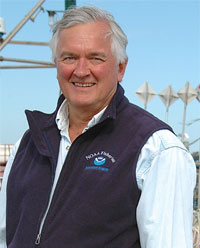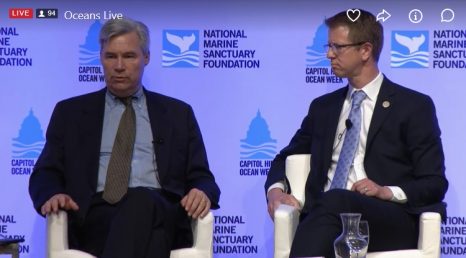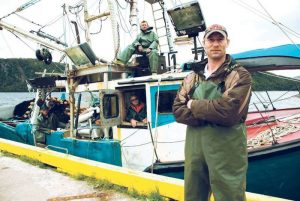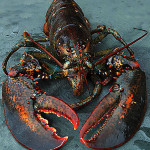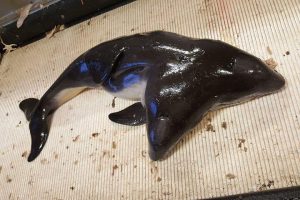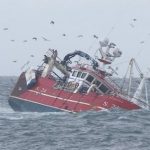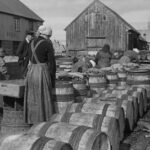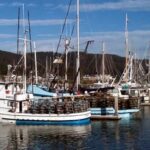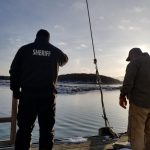Monthly Archives: June 2017
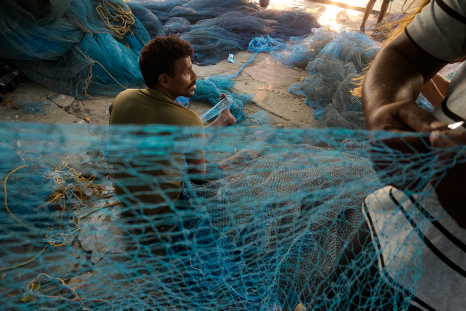
Asia Is Trawling for a Deadly Fishing War
THALVUPADU, Sri Lanka — Stanley Cruz, a fisher in this beachside village on the island of Mannar off Sri Lanka’s northwestern coast, stands with his bare feet in the sand, holding up a green net between his hands. “This is the kind of net, you see. Last week, we lost many hundreds of these. “It keeps happening over and over,” says Mary Subramali, an elderly woman who cleans and sorts the incoming fish. “The trawlers come to take our fish and cut our nets, destroying them with their propellers. My son just lost his for the second time.” She picks up a cold, slippery fish from a basket and severs its head and fins with ease. For her and others on the northern coast of Sri Lanka, losing nets has become a familiar story. Over 30,000 people from the minority Tamil community in Thalvupadu work as fishers, mainly on a small-scale, mostly earning less than $2,500 per year, about two-thirds of the islands’ average. Nets in these coastal societies are precious investments — even a small one costs $23, and the village has lost nearly 1,000 of them. A very good read. click here to read the story 18:28
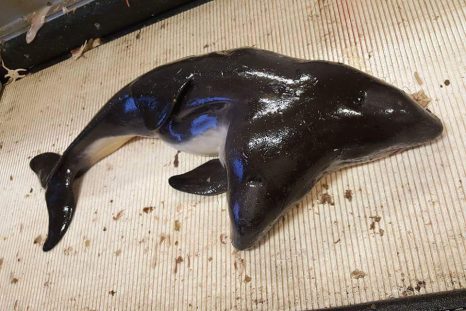
Dutch Fishermen catch rare two-headed porpoise
A fishing vessel in the North Sea between the UK, the Netherlands, and Scandinavia found quite the catch last month: the first-ever documented two-headed harbor porpoise. The dead conjoined porpoise twins were caught up in the GO9 Onderneming fishing vessel’s trawl net on May 30, according to the Natural History Museum of Rotterdam’s journal Deinsea. The Dutch museum said the ship’s workers were “astonished” to find that the animal had what appeared to be two heads. They took pictures and then threw it overboard. The crew thought it would be illegal to keep the dead porpoise, so the actual specimen is now lost to the ocean. click here to read the story 16:22
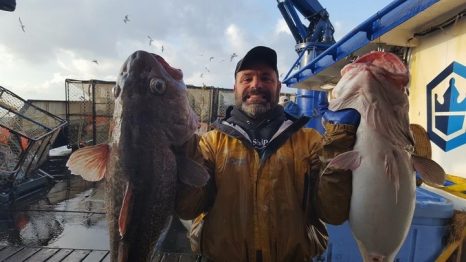
Matt Bradley Of ‘Deadliest Catch’ Shows That Recovery From Addiction Is Possible No Matter What
Although I’m in long term recovery and I work in the treatment industry, I still encounter people whose recovery amazes me. Matt Bradley is one of those people. Matt caught my attention when I saw him on an episode of Deadliest Catch. He’s a fisherman who has crewed with Northwestern for over a decade. What intrigued me wasn’t just the drama and action of the fishing crew, but Matt’s openness and honesty about his struggle with substance use. A long time drug user, Matt didn’t encounter the serious consequences that so many people face until he was in his 20s. Although he grew up with normalized drug use—-stealing joints and alcohol from the adults in his Section 8 housing development—-he didn’t really think he had a problem until he started using heroin. click here to read the story 15:40
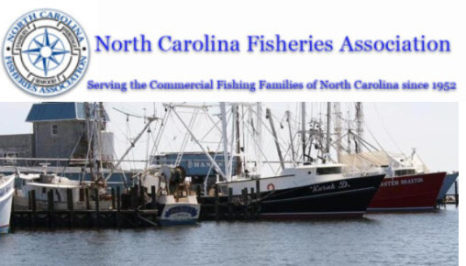
North Carolina Fisheries Association Weekly Update for June 16, 2017
Click here to read the Weekly Update, to read all the updates, Click here Seafood Lobby Day this past Wednesday was a tremendous success! 15:02

In This Alaska Family, Life Lessons Are Passed Down On The Water
We’re on the Alexa K, a 45-foot steel-hulled troller, with captain Charlie Wilber, 69, and his 27-year-old daughter, Adrienne, “heading out into the briny deep!” as Charlie wryly tells us. Charlie has been fishing these waters for nearly 40 years. “I never would have imagined I’d end up doin’ this,” he says. Raised in Omaha, Neb., he came to Alaska fresh out of college. He had a job as a smoke jumper, fighting fires near Fairbanks. But once he went out fishing with a friend, he “got the bug,” as he puts it. He’s been fishing ever since. And it’s always been a family adventure. Charlie says he bought the Alexa K because the boat’s bulwarks were high enough that his daughters, Adrienne and her younger sister, Berett, couldn’t fall off. click here to read the story, view 11 images 11:04
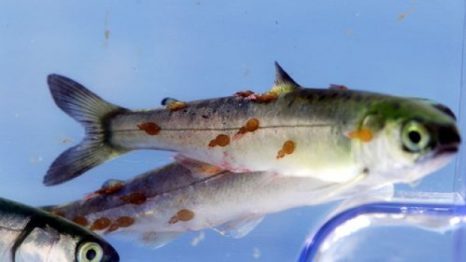
Salmon farms should be worried about more than just one species of sea lice
Migrating young sockeye salmon that are highly infected with parasitic sea lice grow more slowly, according to a new study from Simon Fraser University researchers. That matters, the experts said, because growing quickly can be the difference between life and death for vulnerable juvenile salmon. “Previous studies have shown that to survive to adulthood, young salmon need to get big fast,” said Sean Godwin, a PhD student at SFU and lead author on the study. “Those that grow more slowly — as we found, those heavily infected with sea lice — those fish are more likely to die.” Many people opposed to fish farms have raised concern over declining wild Fraser River sockeye and the potential for parasite transfer from salmon farms. click here to read the story 10:23
Ocean polluters seek to have convictions overturned
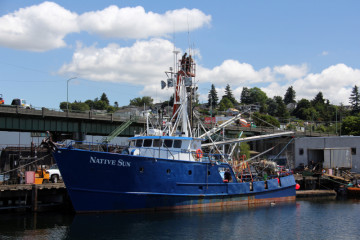 A father-son team that was convicted of polluting Puget Sound and the ocean have asked a judge to toss their convictions. In Seattle federal court on Friday, Bingham Fox asked the judge to throw out his conviction for violating the Clean Water Act. His attorney accused the government of “prosecutorial misconduct.” Fox and his son Randall Fox were convicted of pumping oily bilge water from their 80 fishing vessel “Native Sun.” A deckhand provided the US Coast Guard with a video showing a makeshift pump that pumped engine oil overboard while the vessel was in Blaine harbor. Federal law requires commercial vessels to filter out engine oil and dispose of it properly on shore, which costs time and money. click here to read the story 09:12
A father-son team that was convicted of polluting Puget Sound and the ocean have asked a judge to toss their convictions. In Seattle federal court on Friday, Bingham Fox asked the judge to throw out his conviction for violating the Clean Water Act. His attorney accused the government of “prosecutorial misconduct.” Fox and his son Randall Fox were convicted of pumping oily bilge water from their 80 fishing vessel “Native Sun.” A deckhand provided the US Coast Guard with a video showing a makeshift pump that pumped engine oil overboard while the vessel was in Blaine harbor. Federal law requires commercial vessels to filter out engine oil and dispose of it properly on shore, which costs time and money. click here to read the story 09:12
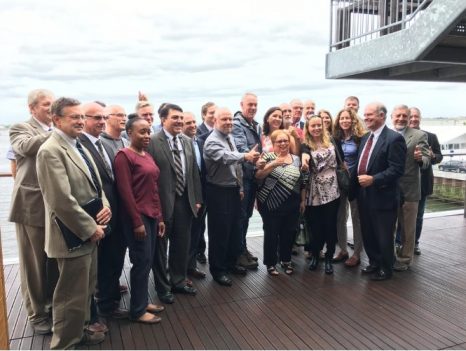
A meeting with Interior Secretary Ryan Zinke – Concerns aired about Northeast Canyons and Seamounts Marine National Monument
Fishing groups from around New England met with Interior Secretary Ryan Zinke on Friday to air complaints about former President Barack Obama’s designation of the Northeast Canyons and Seamounts Marine National Monument last year. The monument, the first marine national monument in U.S. Atlantic waters, protects about 4,000 square miles of ocean 150 miles southeast of Cape Cod. Fishermen say the protected area in which fishing is prohibited hurts their business and places an undue burden on an already heavily regulated industry. But Priscilla Brooks, vice president and director of ocean conservation at the Conservation Law Foundation, said the former administration did take fishermen’s concerns into account. Obama reduced the size of the original proposed monument by 60 percent and allowed lobster and crab fishermen a seven-year grace period to continue fishing there. “There was a robust public process,” she said. (BS!) click here to read the story 08:25
Zinke moving dozens of senior Interior Department officials in shake-up
 Interior Secretary Ryan Zinke is reassigning dozens of top career officials within his ranks, a shake-up that appears to be the start of a broad reorganization of a department that manages one-fifth of all land within the United States. The decision to move members of the Senior Executive Service (SES) is legally permitted only after a political appointee has been in office for 120 days; Zinke won’t reach that mark until June 28.,,,The officials who received notices include Interior’s top climate policy official, Joel Clement, who directs the Office of Policy Analysis, as well as at least five senior officials of the Fish and Wildlife Service — nearly a quarter of that agency’s career SES staff. click here to read the story 18:46
Interior Secretary Ryan Zinke is reassigning dozens of top career officials within his ranks, a shake-up that appears to be the start of a broad reorganization of a department that manages one-fifth of all land within the United States. The decision to move members of the Senior Executive Service (SES) is legally permitted only after a political appointee has been in office for 120 days; Zinke won’t reach that mark until June 28.,,,The officials who received notices include Interior’s top climate policy official, Joel Clement, who directs the Office of Policy Analysis, as well as at least five senior officials of the Fish and Wildlife Service — nearly a quarter of that agency’s career SES staff. click here to read the story 18:46
Searching for Atlantic bluefin tuna larvae and more in the Slope Sea
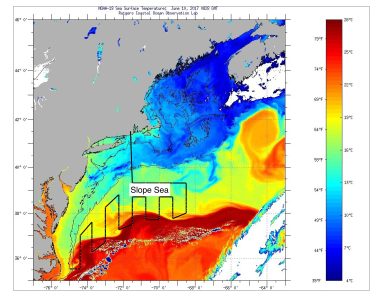 The NOAA Vessel Gordon Gunter departed on June 10 from Newport, Rhode Island, and immediately headed off the continental shelf to water deeper than 1,000 meters (about 3,300 feet) known as the Slope Sea. The Slope Sea is an area of the ocean that is bounded to the north and west by the northeast United States Continental Shelf and to the south by the Gulf Stream, whose dynamic currents provide a strong influence over the area.,,, In recent decades, the common view of Atlantic bluefin tuna was that they spawned only in two places, the Mediterranean Sea in the Eastern Atlantic and the Gulf of Mexico in the western Atlantic. However, in the summer of 2013 two cruises sampled the Slope Sea, both of them achieving noteworthy catch rates of early-stage bluefin tuna larvae. These collections were consistent with a hypothesis first put forward in the 1950s that the Slope Sea was a third spawning ground for this species. Follow up sampling in 2016 again achieved notable catch rates of bluefin tuna larvae. click here to read the story 15:37
The NOAA Vessel Gordon Gunter departed on June 10 from Newport, Rhode Island, and immediately headed off the continental shelf to water deeper than 1,000 meters (about 3,300 feet) known as the Slope Sea. The Slope Sea is an area of the ocean that is bounded to the north and west by the northeast United States Continental Shelf and to the south by the Gulf Stream, whose dynamic currents provide a strong influence over the area.,,, In recent decades, the common view of Atlantic bluefin tuna was that they spawned only in two places, the Mediterranean Sea in the Eastern Atlantic and the Gulf of Mexico in the western Atlantic. However, in the summer of 2013 two cruises sampled the Slope Sea, both of them achieving noteworthy catch rates of early-stage bluefin tuna larvae. These collections were consistent with a hypothesis first put forward in the 1950s that the Slope Sea was a third spawning ground for this species. Follow up sampling in 2016 again achieved notable catch rates of bluefin tuna larvae. click here to read the story 15:37
FISH-NL applauds appeal court decision reaffirming FFAW failed its membership
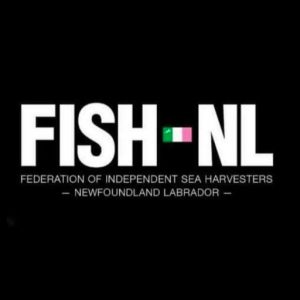 The Federation of Independent Sea Harvesters of Newfoundland and Labrador (FISH-NL) applauds an appeal court decision today reaffirming the FFAW failed its membership. The union had appealed a March, 2016 Supreme Court of Newfoundland and Labrador ruling in favour of scallop fishermen who took the union to court over a compensation fund for lost fishing grounds in the Strait of Belle Isle. In the unanimous ruling handed down today, the three judges with the Supreme Court of Newfoundland and Labrador, Court of Appeal, found that the “FFAW was clearly acting outside its usual role and did not appreciate the full implications of its behaviour.” Click here to read the press release 14:54
The Federation of Independent Sea Harvesters of Newfoundland and Labrador (FISH-NL) applauds an appeal court decision today reaffirming the FFAW failed its membership. The union had appealed a March, 2016 Supreme Court of Newfoundland and Labrador ruling in favour of scallop fishermen who took the union to court over a compensation fund for lost fishing grounds in the Strait of Belle Isle. In the unanimous ruling handed down today, the three judges with the Supreme Court of Newfoundland and Labrador, Court of Appeal, found that the “FFAW was clearly acting outside its usual role and did not appreciate the full implications of its behaviour.” Click here to read the press release 14:54
NOAA Fisheries Announces Reimbursement Rate of 60 Percent for 2017 At-Sea Monitoring Costs in Groundfish Fishery
 Effective at-sea monitoring (ASM) programs are essential to the success and sustainability of Greater Atlantic Region fisheries. Groundfish vessels in the Greater Atlantic Region that participate in the sector program are required to carry a fisheries observer or an at-sea monitor for a portion of their trips. Fisheries observers are provided and typically paid for by the Federal government in the Standardized Bycatch Reporting Methodology (SBRM) program and at-sea monitors are partially paid for by industry in the at-sea monitoring program. In 2016, industry began paying their portion of at-sea monitoring costs and NOAA Fisheries was able to reimburse 85 percent of industry’s expenses for July 2016-April 2017. Read the press release here 13:01
Effective at-sea monitoring (ASM) programs are essential to the success and sustainability of Greater Atlantic Region fisheries. Groundfish vessels in the Greater Atlantic Region that participate in the sector program are required to carry a fisheries observer or an at-sea monitor for a portion of their trips. Fisheries observers are provided and typically paid for by the Federal government in the Standardized Bycatch Reporting Methodology (SBRM) program and at-sea monitors are partially paid for by industry in the at-sea monitoring program. In 2016, industry began paying their portion of at-sea monitoring costs and NOAA Fisheries was able to reimburse 85 percent of industry’s expenses for July 2016-April 2017. Read the press release here 13:01
Hearing on new shrimp rules draws tiny crowd in Ellsworth
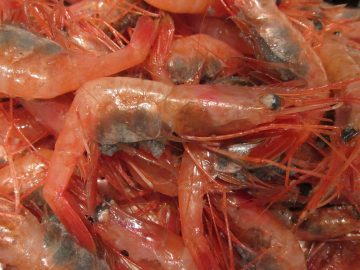 Fishermen barely outnumbered representatives of the Atlantic States Marine Fisheries Commission last Thursday at a public hearing in City Hall on proposed rule changes that would reshape shrimp fishing in the Gulf of Maine. Three fishermen — John Williams and Ricky Trundy, both of Stonington, and James West of Sorrento — offered comments on a proposed amendment to the ASMFC fisheries management plan for northern shrimp. Department of Marine Resources External Affairs Director Terry Stockwell and Resource Management Coordinator Trisha Cheney dutifully recorded those comments on behalf of the ASMFC. Although a somewhat larger crowd was on hand for a hearing the previous evening in Augusta, the sparse audience reflected the state of the fishery from Downeast waters. click here to read the story 12:34
Fishermen barely outnumbered representatives of the Atlantic States Marine Fisheries Commission last Thursday at a public hearing in City Hall on proposed rule changes that would reshape shrimp fishing in the Gulf of Maine. Three fishermen — John Williams and Ricky Trundy, both of Stonington, and James West of Sorrento — offered comments on a proposed amendment to the ASMFC fisheries management plan for northern shrimp. Department of Marine Resources External Affairs Director Terry Stockwell and Resource Management Coordinator Trisha Cheney dutifully recorded those comments on behalf of the ASMFC. Although a somewhat larger crowd was on hand for a hearing the previous evening in Augusta, the sparse audience reflected the state of the fishery from Downeast waters. click here to read the story 12:34
Devon fishing port invited to twin with America’s top port
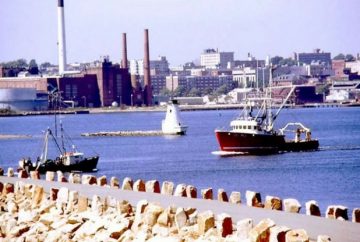 America’s top fishing port has approached Brixham, which was recently crowned the UK’s port of the year for the second year running, to see if it would be interested in twinning. The port of New Bedford, in Massachusetts, USA, has much in common with the South Devon port. Torbay councillor Vic Ellery gave a presentation to Brixham Town Council at its meeting on Thursday evening. Cllr Ellery said he had been approached by South Western Fish Producers Organisation chief executive Jim Portus, at the request of the director of New Bedford Harbour Development Commission, to enquire whether Brixham Town Council would be interested in setting up a twinning arrangement. “The mayor’s office of this city of New Bedford is very keen to arrange a civic, tourism and economic partnership to the benefit of both ports.” click here to read the story 09:48
America’s top fishing port has approached Brixham, which was recently crowned the UK’s port of the year for the second year running, to see if it would be interested in twinning. The port of New Bedford, in Massachusetts, USA, has much in common with the South Devon port. Torbay councillor Vic Ellery gave a presentation to Brixham Town Council at its meeting on Thursday evening. Cllr Ellery said he had been approached by South Western Fish Producers Organisation chief executive Jim Portus, at the request of the director of New Bedford Harbour Development Commission, to enquire whether Brixham Town Council would be interested in setting up a twinning arrangement. “The mayor’s office of this city of New Bedford is very keen to arrange a civic, tourism and economic partnership to the benefit of both ports.” click here to read the story 09:48
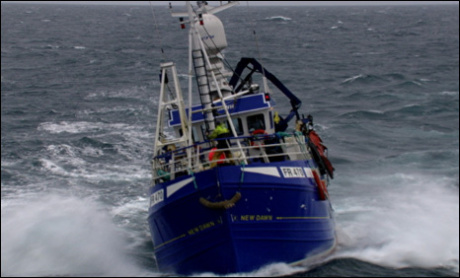
Trawlermen vs Turbines: Offshore Wind Farms Putting Scottish Fishermen Out of Business
Celebrated in the BBC reality TV series, ‘Trawlermen’ the men that brave the waves in search of the seafood that graces British dining tables, restaurants and fish and chip shops risk life and limb to bring the catch home. Ruthlessly competitive, British fishermen not only have to contend with mountainous seas and other Trawlermen, now the fishing grounds that they fiercely guard as their own are literally being stolen out from under them. In just the latest example, Scottish Trawlermen operating in the Moray Firth are about to be displaced by hundreds of offshore wind turbines. The fishermen concerned are hoping that they might receive some kind of compensation for the massive financial loss. From STT’s long association with the wind industry, we wish them luck – they’re going to need it. click here to read the story 08:12
‘They’re not relevant’: Fisheries union boss says Ryan Cleary desperate for a headline
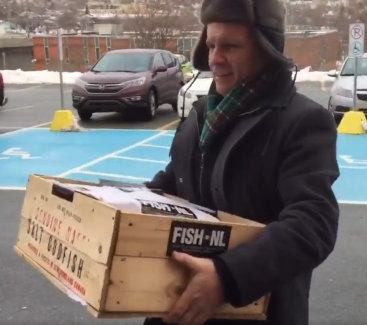 It’s been nine months since a bare knuckles battle began over the right to represent inshore harvesters in Newfoundland and Labrador, and both sides say they want a deciding round to start soon. The upstart Federation of Independent Sea Harvesters of Newfoundland and Labrador (FISH-NL) is waging a fight to bust up the powerful Fish, Food and Allied Workers union (FFAW), and there’s no end in sight to this very public feud. FISH-NL has applied to the labour relations board for a certification vote so harvesters can decide once and for all who they want to represent their interests. But that process has dragged on for months, with the board only saying that it’s an ongoing matter. “We have a situation where you’ve got 2,500 harvesters who are connected to FISH-NL who are invisible to the FFAW,” said FISH-NL president Ryan Cleary. click here to read the story 22:47
It’s been nine months since a bare knuckles battle began over the right to represent inshore harvesters in Newfoundland and Labrador, and both sides say they want a deciding round to start soon. The upstart Federation of Independent Sea Harvesters of Newfoundland and Labrador (FISH-NL) is waging a fight to bust up the powerful Fish, Food and Allied Workers union (FFAW), and there’s no end in sight to this very public feud. FISH-NL has applied to the labour relations board for a certification vote so harvesters can decide once and for all who they want to represent their interests. But that process has dragged on for months, with the board only saying that it’s an ongoing matter. “We have a situation where you’ve got 2,500 harvesters who are connected to FISH-NL who are invisible to the FFAW,” said FISH-NL president Ryan Cleary. click here to read the story 22:47
Interior secretary set to visit Boston as enviros launch marine monument campaign
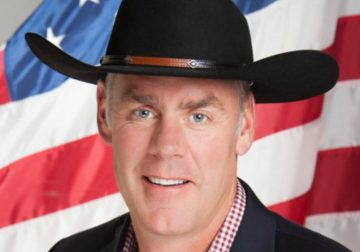 When Interior Secretary Ryan Zinke visits the Boston area on Friday, environmentalists plan to greet him by rallying for the preservation of national monuments that are under review by the Trump administration. The former Montana congressman has an 11 a.m. press event at a Legal Sea Foods location, according to his office. The Bay State visit could also afford the interior secretary a chance to meet with the state’s top Republican, Gov. Charlie Baker, although nothing has been announced. The fishing industry opposed President Barack Obama’s 2016 designation of the Northeast Canyons and Seamounts Marine National Monument on a roughly 4,900 square-mile area south of Cape Cod. According to a Zinke press aide, the secretary on Friday will meet with a U.S. Fish and Wildlife Service officials and officials from the New England Aquarium about marine wildlife around the monument. The secretary will then attend a roundtable meeting with lobstermen and fishermen about the impact of the monument designation on their industry. click here to read the story 18:36
When Interior Secretary Ryan Zinke visits the Boston area on Friday, environmentalists plan to greet him by rallying for the preservation of national monuments that are under review by the Trump administration. The former Montana congressman has an 11 a.m. press event at a Legal Sea Foods location, according to his office. The Bay State visit could also afford the interior secretary a chance to meet with the state’s top Republican, Gov. Charlie Baker, although nothing has been announced. The fishing industry opposed President Barack Obama’s 2016 designation of the Northeast Canyons and Seamounts Marine National Monument on a roughly 4,900 square-mile area south of Cape Cod. According to a Zinke press aide, the secretary on Friday will meet with a U.S. Fish and Wildlife Service officials and officials from the New England Aquarium about marine wildlife around the monument. The secretary will then attend a roundtable meeting with lobstermen and fishermen about the impact of the monument designation on their industry. click here to read the story 18:36
Cause of Action Digs In: Northeast Canyons and Seamounts Designation: Some Stakeholders Are More Equal Than Others
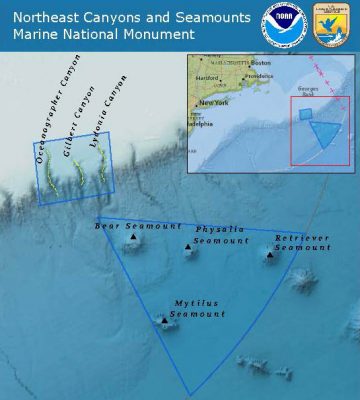 This week we review the procedural history of the Northeast Canyons and Seamounts Marine National Monument (“Atlantic Monument” or “Monument”) designation, which was made by President Obama on September 15, 2016 (“Proclamation”), and show that certain, privileged, non-governmental entities were granted access to detailed information on the forthcoming monument and allowed input into the designation, while other stakeholders—notably those with specific legal authority, such as Regional Fishery Councils—were denied input and access.,,, The following history, derived from the partial responses to CoA Institute’s FOIA requests and other publicly available documents, is illustrative: In March 2015, the Conservation Law Foundation (“CLF”) and Natural Resources Defense Council (“NRDC”),,, click here to read the story. Hang onto your Sou’wester. 17:53
This week we review the procedural history of the Northeast Canyons and Seamounts Marine National Monument (“Atlantic Monument” or “Monument”) designation, which was made by President Obama on September 15, 2016 (“Proclamation”), and show that certain, privileged, non-governmental entities were granted access to detailed information on the forthcoming monument and allowed input into the designation, while other stakeholders—notably those with specific legal authority, such as Regional Fishery Councils—were denied input and access.,,, The following history, derived from the partial responses to CoA Institute’s FOIA requests and other publicly available documents, is illustrative: In March 2015, the Conservation Law Foundation (“CLF”) and Natural Resources Defense Council (“NRDC”),,, click here to read the story. Hang onto your Sou’wester. 17:53
Feds (No EDF and Pew) complain new Red Snapper season will hurt species’ recovery
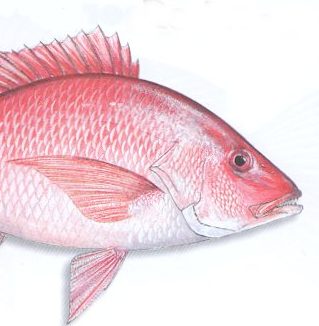 The U.S. Commerce Department says recreational anglers in the Gulf of Mexico will have 39 more days to fish federal waters for red snapper,,,However, an environmental group and a charter captains’ association estimate that private anglers will take nearly triple their allocated 3.4 million-pound (1.5 million kilogram) quota of the sport and panfish under the plan, potentially canceling next year’s recreational season entirely.,,“The current system is failing private anglers and they deserve a fix,” Mike Jennings, president of the Charter Fisherman’s Association said in a prepared statement.,,, Earlier Wednesday, his group and the Environmental Defense Fund had emailed Commerce Secretary Wilbur Ross, asking him to delay any decision until he had good scientific estimates of the likely catch. click here to read the story 16:45
The U.S. Commerce Department says recreational anglers in the Gulf of Mexico will have 39 more days to fish federal waters for red snapper,,,However, an environmental group and a charter captains’ association estimate that private anglers will take nearly triple their allocated 3.4 million-pound (1.5 million kilogram) quota of the sport and panfish under the plan, potentially canceling next year’s recreational season entirely.,,“The current system is failing private anglers and they deserve a fix,” Mike Jennings, president of the Charter Fisherman’s Association said in a prepared statement.,,, Earlier Wednesday, his group and the Environmental Defense Fund had emailed Commerce Secretary Wilbur Ross, asking him to delay any decision until he had good scientific estimates of the likely catch. click here to read the story 16:45
CATCH SHARES – NOT A VIABLE OPTION FOR THE NORTHEAST
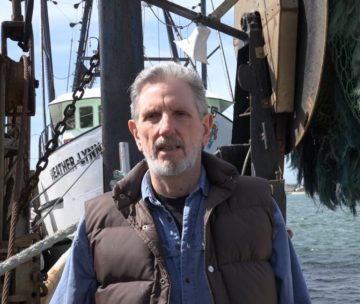 Theoretical constructs that might hold together logically and appear sound often quickly disintegrate in the atmosphere outside their esoteric bubble. This was certainly the case for catch shares or transferable quota management in the New England groundfishery. Catch shares in New England disintegrated almost upon entry. What are catch shares and where did they come from? Catch shares or the commoditization of the fish poundage to be caught, or the ownership of the “right” to harvest a certain portion of the government managers’ scientifically sanctioned total yearly catch, is a construct of “free market environmentalism” theory. The “enviropreneurs” or “enviro-capitalists” claim that ownership equals good stewardship, equals profitability. This privatization push is actually an idea of economics, claiming production “efficiency”, and not one of fishery conservation—although the sales pitch promotes this scheme as the answer to “overfishing”, and just in the nick of time. Click here to read the article 14:58
Theoretical constructs that might hold together logically and appear sound often quickly disintegrate in the atmosphere outside their esoteric bubble. This was certainly the case for catch shares or transferable quota management in the New England groundfishery. Catch shares in New England disintegrated almost upon entry. What are catch shares and where did they come from? Catch shares or the commoditization of the fish poundage to be caught, or the ownership of the “right” to harvest a certain portion of the government managers’ scientifically sanctioned total yearly catch, is a construct of “free market environmentalism” theory. The “enviropreneurs” or “enviro-capitalists” claim that ownership equals good stewardship, equals profitability. This privatization push is actually an idea of economics, claiming production “efficiency”, and not one of fishery conservation—although the sales pitch promotes this scheme as the answer to “overfishing”, and just in the nick of time. Click here to read the article 14:58
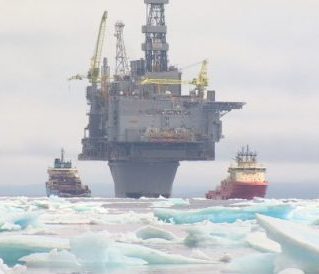
FFAW denies allegation of conflict of interest in relation to Hebron tow-out
The province’s fisheries union is scoffing at an allegation from a rival that it rewarded an influential enterprise owner by giving him a contract to escort the Hebron platform to sea. The Fish, Food and Allied Workers’ union is also defending its relationship with the oil and gas industry.,, The latest flare-up in tension between the FFAW and the Federation of Independent Seafood Harvesters of Newfoundland and Labrador (FISH-NL) relates to the recent tow-out from Trinity Bay of the Hebron platform. The two groups are locked in a bitter feud, with FISH-NL fighting to replace the FFAW as the official bargaining agent for inshore harvesters. click here to read the story 12:38:
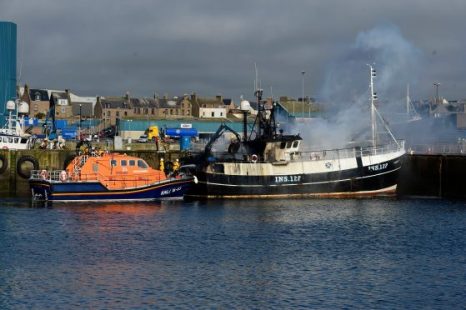
Owner of fire-stricken fishing vessel hits out at safety report findings
The owner of a fishing boat destroyed by a fire has accused safety chiefs of criticising his crew for saving their own lives by escaping from the vessel. Three trawlermen on the Ardent II scrambled to the safety of the Peterhead quay only after one spotted smoke when he got up at 5am to use the toilet. The Marine Accident Investigation Branch (MAIB) launched an investigation into the incident and published its findings yesterday. The MAIB found the crew might have saved the 131ft vessel if they had fought the flames rather than leaping ashore. click here to read the story 12:14
Fishermen watch, wait, work, while Alaska Legislature in limbo
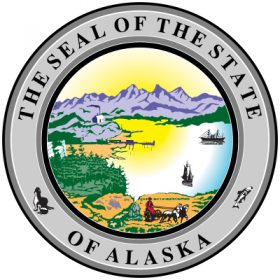 An Alaska government shutdown is a fisheries shutdown. Commercial, sport, gillnet, dipnetters and subsistence fishing would all be impacted in devastating ways if a fiscal year 2018 budget isn’t approved by the Alaska Legislature by July 1. United Fishermen of Alaska, which represents 33 Alaska commercial fishing organizations, is taking the stance that people should “work on the season,” said President Jerry McCune. “As it gets closer to the deadline, we’ll get more worried and put the pressure on the Legislature to fund Fish and Game at least, if they’re not coming up with a budget,” he said. The Alaska Department of Fish and Game’s 2018 fiscal year budget of $200.16 million was agreed upon by both the House and the Senate in April. Of that, commercial fisheries were allotted $70.77 million. click here to read the story 11:34
An Alaska government shutdown is a fisheries shutdown. Commercial, sport, gillnet, dipnetters and subsistence fishing would all be impacted in devastating ways if a fiscal year 2018 budget isn’t approved by the Alaska Legislature by July 1. United Fishermen of Alaska, which represents 33 Alaska commercial fishing organizations, is taking the stance that people should “work on the season,” said President Jerry McCune. “As it gets closer to the deadline, we’ll get more worried and put the pressure on the Legislature to fund Fish and Game at least, if they’re not coming up with a budget,” he said. The Alaska Department of Fish and Game’s 2018 fiscal year budget of $200.16 million was agreed upon by both the House and the Senate in April. Of that, commercial fisheries were allotted $70.77 million. click here to read the story 11:34
Gray seals are making a huge comeback on Cape Cod (where there are no longer any Cod!)
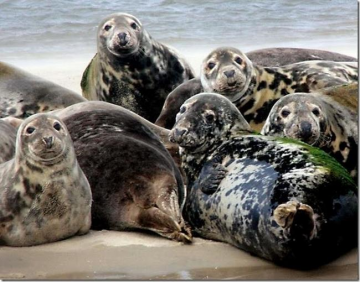 For nearly a hundred years, New England’s gray seals had a bounty on their heads. Maine and Massachusetts paid people to kill them, because they depleted fishing stocks. They were also hunted for their meat and pelts. By 1973—a year after the Marine Mammal Protection Act made it illegal to systematically kill the animals—a census estimated there were only 30 gray seals left along the entire coast of Maine. Since then, Canada’s gray seals have returned to recolonize the east coast of the U.S.,,, Now, in a study published in Bioscience, researchers have combined Google Earth images and data from tagged seals to make a more precise estimation of the population.,, “Our technology-aided aerial survey, which used Google Earth imagery in conjunction with telemetry data from tagged animals, suggests the number is much larger—between 30,000 and 50,000.” Not everyone is happy with the pinniped’s population explosion—particularly fisherman, who see them as competition for fish stocks. In recent years, some groups have advocated for culling the number of gray seals. Johnston says that not only would that be illegal, but it would also be premature. “We know almost nothing about what gray seals eat, how and where they forage,,, click here to read the story 10:48
For nearly a hundred years, New England’s gray seals had a bounty on their heads. Maine and Massachusetts paid people to kill them, because they depleted fishing stocks. They were also hunted for their meat and pelts. By 1973—a year after the Marine Mammal Protection Act made it illegal to systematically kill the animals—a census estimated there were only 30 gray seals left along the entire coast of Maine. Since then, Canada’s gray seals have returned to recolonize the east coast of the U.S.,,, Now, in a study published in Bioscience, researchers have combined Google Earth images and data from tagged seals to make a more precise estimation of the population.,, “Our technology-aided aerial survey, which used Google Earth imagery in conjunction with telemetry data from tagged animals, suggests the number is much larger—between 30,000 and 50,000.” Not everyone is happy with the pinniped’s population explosion—particularly fisherman, who see them as competition for fish stocks. In recent years, some groups have advocated for culling the number of gray seals. Johnston says that not only would that be illegal, but it would also be premature. “We know almost nothing about what gray seals eat, how and where they forage,,, click here to read the story 10:48
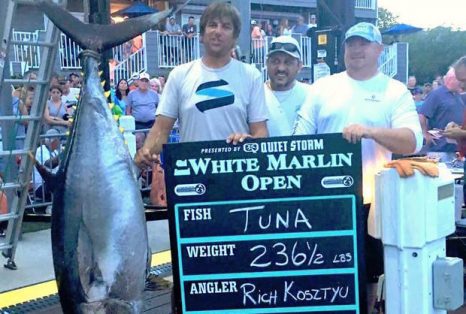
Judge strips $2.8M tournament prize from Fla. fisherman
A federal judge on Wednesday ruled that a Florida fisherman is not entitled to the $2.8 million in prize money he won in a Maryland fishing tournament last summer. Phillip Heasley and the crew of his Naples, Fla.-based boat, the Kallianassa, put their fishing lines in too early, violating the rules of the White Marlin Open in Ocean City, Md., the judge ruled. Three New Jersey men – Trenton police sergeant Brian Suschke, Trenton firefighter Rich Kosztyu and Ocean County boat owner Damien Romeo – could land $2.3 million of the money, but the judge’s decision did not yet rule on the awarding of the money. Because the matter is still technically pending, with a decision expected on the money, Suschke declined further comment, except to say the three men are “happy to have cleared one legal hurdle.” click here to read the story 09:49
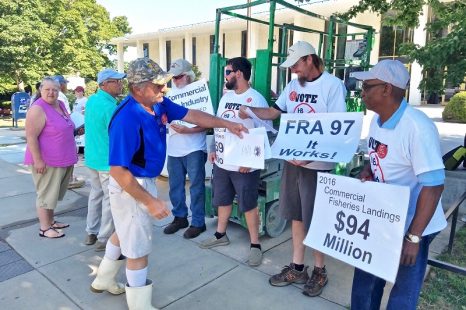
Watermen, locals descend on Raleigh to fight fisheries bill – The true toll of a treacherous bill on commercial fishing
Hundreds of commercial fishermen and their families, along with local government and agency leaders spent Wednesday walking the halls of the North Carolina Legislative Building in an effort to battle a bill they say could shut down the entire industry. House Bill 867 would attempt to rewrite the Fisheries Reform Act, which is the body of statutes that provides the framework for fisheries management in North Carolina. The event was organized by North Carolina Watermen United and the North Carolina Fisheries Association.,, But just as opponents were arriving on Jones Street in Downtown Raleigh, many wearing white T-shirts and red buttons calling for a no vote, word trickled out that the legislation was being amended. click here to read the story 08:47
The true toll of a treacherous bill on commercial fishing – Sandy Semans Ross – If he had bothered to come, I wanted to explain what is obvious to me but apparently less so to others. But he didn’t come, so I share my words with you. I would have told him that the coastal economy as a whole is unique because of its proximity to the ocean and the sounds. click here to read the story
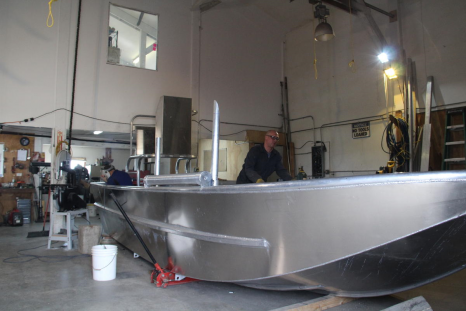
Naknek’s Fishy Fabrications takes on skiff building this spring
‘Fishy Fabrications,’ a local business in Naknek, has started building skiffs from the ground up, something only a few other local businesses do in Bristol Bay. George Wilson and Robert Hill are working long hours these days to finish building skiffs before the salmon season takes off. Often 10 hours a day, seven days a week. “And that’s with two dads we both have kid duties during the week,” Wilson said. “This is just a good off-season job for both of us from commercial fishing – we do this in the winter and spring.” Wilson is the owner of ‘Fishy Fabrications’ and Hill is his right hand man. Since 2013 the business was more of a repair shop, but this March it shifted to a skiff building operation. Since then, he and Hill have built two set net skiffs. Audio, click to read the story 19:06
Department of Commerce Announces Changes to the 2017 Gulf of Mexico Red Snapper Private Angler Recreational Season
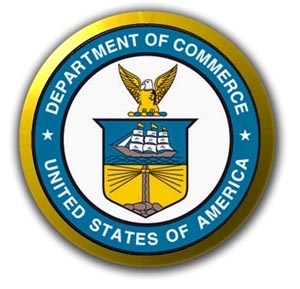 For the first time in a decade, Federal authorities and the five Gulf States have agreed to align Federal and State private angler red snapper fishing seasons for the remainder of the summer, and the Department of Commerce has re-opened the 2017 private angler recreational season for 39 weekend days and holidays. Majority Whip Scalise and other Members of Congress were instrumental in reaching this agreement. The agreement reached between the Secretary of Commerce and the five Gulf States is a significant step forward in building a new Federal-State partnership in managing the Gulf of Mexico red snapper stock.The Departments rule does not change the quota or season length for the federally permitted for-hire component of the recreational fishery or the commercial individual fishing quota program and the 2017 commercial quota. Click here to read the press release 18:13
For the first time in a decade, Federal authorities and the five Gulf States have agreed to align Federal and State private angler red snapper fishing seasons for the remainder of the summer, and the Department of Commerce has re-opened the 2017 private angler recreational season for 39 weekend days and holidays. Majority Whip Scalise and other Members of Congress were instrumental in reaching this agreement. The agreement reached between the Secretary of Commerce and the five Gulf States is a significant step forward in building a new Federal-State partnership in managing the Gulf of Mexico red snapper stock.The Departments rule does not change the quota or season length for the federally permitted for-hire component of the recreational fishery or the commercial individual fishing quota program and the 2017 commercial quota. Click here to read the press release 18:13








